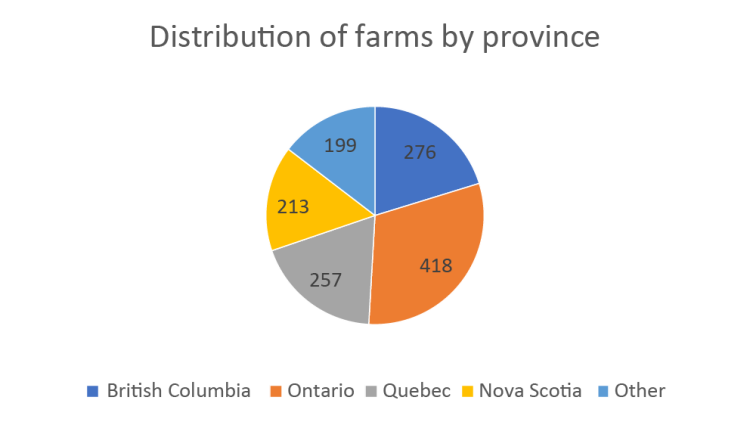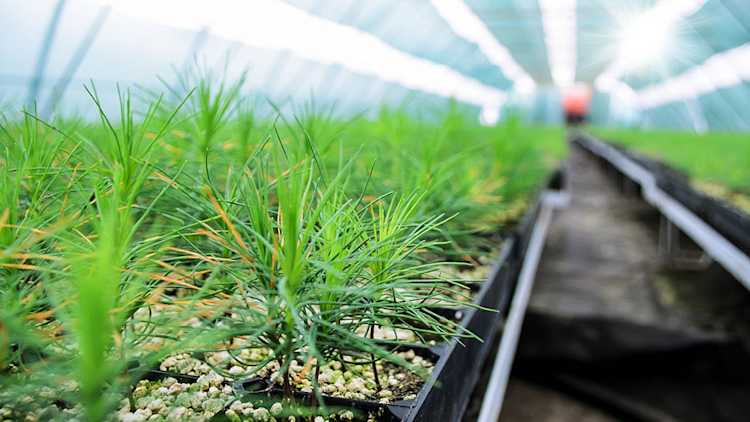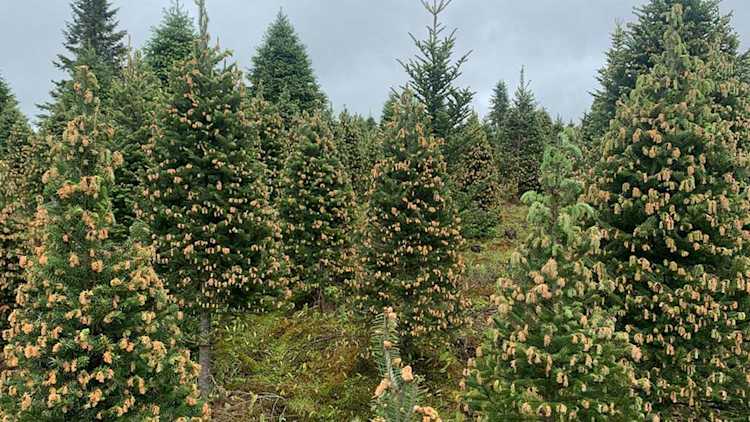The life cycle of a Christmas tree

Coniferous trees were first used as Christmas decorations 400 years ago in Germany. The tradition later spread to the rest of Europe. On our side of the ocean, a German immigrant brought the custom to Sorel, Quebec, in 1781. Historically, trees were cut down in the forest, but now only 2% of the harvest is done this way. Indeed, 98% of the Christmas trees produced in Canada are farm-grown.
In 2021, according to Statistics Canada, there were 1,364 Christmas tree producers and 50,803 acres of trees in Canada (Figure 1). Ontario had the largest number of producers, followed by British Columbia and then Quebec. However, with 19,169 acres in production, Quebec was first in cultivated acres, with the main regions being Estrie and Chaudière-Appalaches. Their soil and climate are particularly well-suited to producing fir trees, but it is also a typical family tradition in those regions. In addition, proximity to our southern neighbours has facilitated the development of exports.
Figure 1

Source: Census 2021, Statistics Canada
Farm cash receipts for Canadian Christmas tree producers totalled nearly $163.5 million in 2021. More than 2.4 million trees were sold on the export market, mainly from Quebec. The main buyers are in the United States, but Canadian Christmas trees are also found in Panama, Bermuda, etc. At least ten others are growing for every tree cut, making for a sustainable annual harvest. But what are the steps in Christmas tree farming?
Seedlings
Christmas tree production usually begins by sowing seeds in a greenhouse operated by specialized greenhouse growers. It takes two to three years for seedlings to reach the required height (30 to 40 cm) for transplanting. Some large farms sometimes plant seeds directly in the field. Fraser and balsam fir are the common types grown. Fraser firs have a slightly bluish hue. Their branches are sturdy, and they keep their needles longer. Balsam fir has a stronger scent; it tolerates moist soil better and is perfectly suited to the climate of Quebec and Ontario. Other varieties, such as Canaan and Cook firs, are also found, but to a lesser extent.

Image: Greenhouse production of transplants
Planting
The fields must be prepared beforehand. It is important to assess drainage and fertilizer needs. Weeding and tilling the soil is also necessary to prepare for the new plantings. A mechanical planter can be mounted on a tractor to transplant the trees. It creates a furrow and deposits the seedlings. It can also be done manually, for instance, when you want to establish new trees within a mature crop that will be harvested the following year or around stumps. Transplants can be bare-root or in a bucket. The operation takes place early in the spring. On average, there are at least 1,000 seedlings per acre. A ground cover is then installed between the rows. This helps to limit the growth of unwanted plants while reducing erosion. A study for the Christmas Tree Council of Nova Scotia published in 2022 reported that establishing a new crop costs about $2,200 per acre.
Growth
Pests appear in late spring and summer, requiring careful monitoring. One or more applications of fertilizer may also be recommended. Pruning is done annually after the buds open. The goal is to obtain the most symmetrical cone shape possible. The operation continues throughout the summer, ensuring strong growth and a lush appearance. The trees are then tagged with ribbons to categorize them by shape. The ribbons are colour-coded to help when cutting. Also important is inventory tracking, which can be a difficult task. Testing is being done with drones to count trees and measure their height and density. Such technologies could also make it possible to diagnose and solve problems with disease, fertilization or soil compaction. It takes 10 to 14 years for a Christmas tree to mature.

Image: Mature planting
Harvest and marketing
Harvesting of mature trees is done before mid-November. The trees are then wrapped in netting and transported to a shady place sheltered by wind. They will later be delivered to different points of sale or exported.

Image: Wrapped trees ready to be stored before delivery
A different marketing option is gaining popularity among some producers offering cut-your-own trees. Cutting down the tree becomes a family activity, where everyone can walk around the site and select the one that will adorn the home. It is then cut down the old-fashioned way.
In recent years, there has been a decrease in inventory and a shortage of trees on the market. On the one hand, sales have increased, while on the other, the number of farms is declining. There has been a lower turnover of crops, and tree growth has been affected by bad weather. Young trees have difficulty surviving spring freezes and drought, and trees of all ages have difficulty tolerating heat waves during the growing season. Excess water causes root diseases. In addition, reduced winter snowfall combined with high winds causes trees to dry out, increasing mortality. In recent years, all provinces have faced one or more of these conditions. In addition, the weak Canadian dollar has made export sales very attractive. Christmas tree availability has, therefore, been low even though demand is high. Nevertheless, tree producers are not expecting another shortage this year.

Image: Christmas trees affected by spring frost Photo courtesy APANQ
Since Christmas is on our doorstep, here are some tips to help your tree last. Cut a centimetre off the base of the trunk to remove the sap plug formed after cutting, which prevents the tree from taking in water. In addition, if you buy early, keep the tree out of the sun and wind and put it in a pot of water until you're ready to bring it inside. After the holidays, you can put it outside, and it will keep its colour until spring. Most municipalities also collect them to make mulch. Did you know that some companies also produce pot-grown Christmas trees? They can be planted in your yard in the spring. Otherwise, renting a tree for the holiday season and returning it is sometimes possible.
Happy Holidays!
Judith Francoeur, agr., Data Specialist, FCC